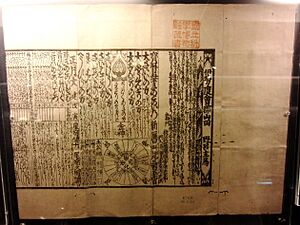Hōryaku calendar facts for kids
The Hōryaku calendar (宝暦暦, Hōryaku-reki) was a special way to keep track of time in Japan. It was a type of lunisolar calendar. This means it used both the Moon's phases and the Sun's position to figure out dates. People also called it the Horiki Kojutsu Gen-reki. It was first used in 1755.
Contents
Understanding the Hōryaku Calendar
The Hōryaku calendar was a system for telling time. It was based on the movements of both the Moon and the Sun. This type of calendar is called a lunisolar calendar. It helped people know when to plant crops and celebrate festivals.
Who Created the Hōryaku Calendar?
Three smart people worked together to create this calendar. They were Abe Yasukuni, Shibukawa Kōkyō, and Nishiyama Seikyū. They used their knowledge of astronomy and math to design it.
Why Calendars Change Over Time
Even the best calendars can have small mistakes over many years. These errors can cause the calendar to slowly drift out of sync with the seasons. Because of this, the Hōryaku calendar needed updates.
Fixing the Hōryaku Calendar
Scientists and astronomers made corrections to the Hōryaku calendar. These updates happened in 1798 and again in 1844. This helped keep the calendar accurate for a longer time.
When Japan Changed Calendars
In 1872, Japan decided to adopt the Western calendar. This is the calendar most of the world uses today. It uses only the Sun's position to track time. This change made it easier for Japan to connect with other countries.
Related pages
- National Diet Library, "The Japanese Calendar"


